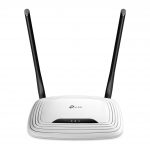A Step-by-Step Guide to Safely Restore TP-Link’s Default Firmware on Your TL-WR841N V10 Router, Regaining Simplicity and Familiarity While Exploring the Fascinating World of Router Firmware Customization.
DD-WRT TL-WR841N V10: How to Restore TP-LINK’s Original Firmware
If you have installed the DD-WRT firmware on your TP-LINK TL-WR841N V10 wireless router and wish to revert to the original TP-LINK firmware, you can follow the steps outlined in the video below.
Restoring the TP-LINK stock firmware is not a difficult process as long as you pay attention to the instructions. However, if you encounter any difficulties, feel free to leave a message, and I will be more than happy to assist you.
instructions. However, if you encounter any difficulties, feel free to leave a message, and I will be more than happy to assist you.
Here’s a step-by-step guide on how to revert to TP-LINK’s default firmware for the TL-WR841N V10 after installing DD-WRT:
Before you begin, please ensure that you have a stable internet connection and a computer connected to the router via an Ethernet cable.
Step 1: Download the TP-LINK Firmware Visit the TP-LINK website and navigate to the support section.
Look for the TL-WR841N V10 router and download the latest version of the stock firmware. Save the file to your computer’s local storage.
Step 2: Access the Router’s Web Interface Open a web browser on your computer and enter the default IP address of the router (usually 192.168.0.1 or 192.168.1.1) into the address bar. Press Enter to access the router’s web interface.
Step 3: Perform a Factory Reset To ensure a clean installation of the stock firmware, it is recommended to perform a factory reset on the router. Locate the small reset button on the back of the router and press and hold it for approximately 10 seconds until the router’s lights blink.
Step 4: Log in to the Router’s Web Interface Once the router has rebooted, reopen your web browser and enter the default IP address again. You should now see the TP-LINK web interface. Enter the default username and password (usually admin for both) to log in.
Step 5: Firmware Upgrade Navigate to the firmware upgrade section in the web interface. Click on the “Choose File” or “Browse” button and select the stock firmware file you downloaded earlier. Click on the “Upgrade” or “Update” button to start the firmware installation process.
Step 6: Wait for the Installation to Complete. The firmware upgrade process may take a few minutes. It is crucial not to interrupt the process or power off the router during this time, as it may lead to firmware corruption. Wait patiently until the installation is complete.
Step 7: Reconfigure the Router Once the installation is finished, the router will reboot. You will need to reconfigure your router’s settings, such as the wireless network name (SSID) and password, to match your preferences.
Step 8: Test the Connection After reconfiguring the router, ensure that your internet connection is working correctly. Connect your computer or other devices to the router’s wireless network and verify that you can access the internet.
Congratulations! You have successfully restored the TP-LINK stock firmware on your TL-WR841N V10 router after using DD-WRT. If you encounter any issues during the process or need further assistance, feel free to seek help from the TP-LINK support forums or leave a message for me, and I’ll be glad to assist you.
Remember to exercise caution when modifying your router’s firmware and always follow the official instructions provided by the manufacturer.
Restoring the TP-LINK stock firmware on your TL-WR841N V10 router is a relatively straightforward process if you carefully follow the steps outlined above. By reverting to the original firmware, you can regain the default functionality and features provided by TP-LINK.
Whether you decided to install DD-WRT for experimentation or specific needs, it’s always good to know how to return to the manufacturer’s firmware. The DD-WRT firmware offers advanced customization options and additional features, but some users may prefer the simplicity and familiarity of TP-LINK’s stock firmware.
I hope that this guide has been helpful in assisting you in reverting to TP-LINK’s original firmware.
Remember, it’s essential to exercise caution and follow the instructions precisely to avoid any potential issues.
Now, I’d love to hear from you! Have you ever tried installing third-party firmware on your router? What was your experience like? Share your thoughts, experiences, or any questions you may have in the comments section below!
